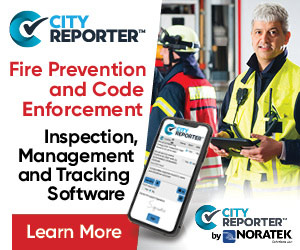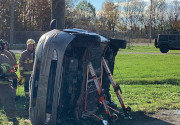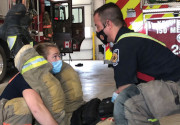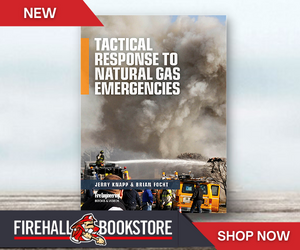View As Webpage | View Archives | Email a Friend
| |
| |
 |
 |
| |
 |
|
@{mv_date_MMM d, yyyy}@ |
|
| |
Quebec’s chief coroner is calling a public inquiry into the drowning of a Montreal firefighter last year. Pierre Lacroix, a father of two, died after he was thrown into the St. Lawrence River during a rescue mission in October.
» Read more
Officials say that while it’s near impossible to forecast what New Brunswick’s summer months will hold in terms of wildfires, the danger is always present. The province lifted burn restrictions across the board Monday following a wet weekend, but according to Wildfire Prevention Officer Roger Collet, the “green” status doesn’t mean there’s no risk at all.
» Learn more
In Alberta, Lethbridge Fire and Emergency Services (LFES) has been grappling with operational staffing issues that have been affecting the quality of service it is able to provide, according to Chief Greg Adair.
» Read more
A civil engineering professor and graduate student at Ontario’s Lakehead University have been awarded a patent in Canada for an embedded steel connection system they invented to join mass timber beams and columns.
» Read more
|
| |
 |
 |
| |
|
| |

Take control by accessing rapid & responsive software for emergency services. Quickly update emergency planning and Fire Prevention for the local community. CityReporter's Fire & Code Enforcement software helps local Fire Departments and Code Enforcement staff meet their code-based inspection requirements and accumulate information for Emergency Planning. Learn more about CityReporter Fire Prevention & Code Enforcement Software
» Learn more |
| |
|
| |
 When thinking about our compliment of auto ex tools and how we evaluate our needs, the one area that is often overlooked or undervalued is the stabilizing and/or lifting struts. While some may argue this is due to their somewhat limited use on our general extrication calls, with the advent of newer struts on the market, today’s strut combinations put that argument to bed very quickly. From their original inception in the rescue world, these tools were used mainly for general stabilization and widening of the vehicle footprint. But now, struts, like many other tools in our trade, have been evaluated, re-engineered and rebranded to make them extremely versatile and valuable to any department, no matter the size or budget. The tricky part is knowing which one or type to go with. By Chad Roberts
» Learn more
When thinking about our compliment of auto ex tools and how we evaluate our needs, the one area that is often overlooked or undervalued is the stabilizing and/or lifting struts. While some may argue this is due to their somewhat limited use on our general extrication calls, with the advent of newer struts on the market, today’s strut combinations put that argument to bed very quickly. From their original inception in the rescue world, these tools were used mainly for general stabilization and widening of the vehicle footprint. But now, struts, like many other tools in our trade, have been evaluated, re-engineered and rebranded to make them extremely versatile and valuable to any department, no matter the size or budget. The tricky part is knowing which one or type to go with. By Chad Roberts
» Learn more |
| |
 At a recent fire, we were confronted with this very question. Our initial update included the report of a basement fire, people trapped and explosions coming from the basement area. On approach we noticed smoke coming from the front door and occupants exiting the house. We were advised by the homeowner, who had self evacuated, that a woman and her child were still in the basement. The hose line was redirected to a side entrance where an exterior door was cut into the side of the building. This led us to a shared room full of pressurized smoke. The hose line was moved into position, and while the fire was being extinguished, a simultaneous rescue effort was underway. The child was rescued up and out of the basement in a matter of seconds. The woman, weighing 385 pounds, was not as easy. By Jared Newcombe
» Learn more
At a recent fire, we were confronted with this very question. Our initial update included the report of a basement fire, people trapped and explosions coming from the basement area. On approach we noticed smoke coming from the front door and occupants exiting the house. We were advised by the homeowner, who had self evacuated, that a woman and her child were still in the basement. The hose line was redirected to a side entrance where an exterior door was cut into the side of the building. This led us to a shared room full of pressurized smoke. The hose line was moved into position, and while the fire was being extinguished, a simultaneous rescue effort was underway. The child was rescued up and out of the basement in a matter of seconds. The woman, weighing 385 pounds, was not as easy. By Jared Newcombe
» Learn more |
| |
|
| |

The firefighter’s mission at gas emergencies is life safety. A near-death experience at a routine gas leak is the genesis for this book, which incorporates hard-won experience, expertise, and battle-tested tactical lessons that will help improve your fire department’s response procedures and training methods.
Are your fire department’s response procedures based on gas industry best practices? Tactical Response to Natural Gas Emergencies explains the proper and rapid size-up of gas emergencies, the uses and limitations of air monitors, new laser-based gas detectors, how to improve your standard operating procedures, all in service of making effective strategic and tactical decisions.
» Order your copy today! |
| |
|
| |
For every situation you encounter in your career, you bring to it the learning and experiences from your past. You need to train the way that you respond in real life, and that means not isolating training to the technical skills you need for one specific type of response, but instead looking at each situation holistically.This is where we need to ask ourselves, what have we learned from our training in ice rescue, fire, high angle rescue, psychological first aid, emergency medical responder training? How can we apply these to the situation we are currently facing?By Steve Piluso
» Read more
|
|
Are you looking at acing your next promotional exam or landing your dream job as a firefighter? If so, then this edition’s column is for you. The tips that I will share here come from personal experience and some inspiration from bestselling author Jim Kwik’s new book Limitless. Kwik is an amazing brain coach and he offers some excellent tips to enhance your ability to ace tests and get the most out of your brain. Kwik notes in his book that “humans forget approximately 50 percent of what they learn within an hour, and an average of 70 percent within 24 hours.” But with a little effort, there are ways we can improve.
» Read more
| | |
| FIRE FIGHTING IN CANADA: THE PODCAST |
|
|
| |
|
Tune in to April’s podcast for a conversation on how public alerts have evolved, why radio is still a key player, what the research shows about public reaction to emergency notifications, best practices for crafting your message, why it’s important to know and address your policy hurdles and how GPS plays a role in the next generation of population targeting. Podcast host Fire Chief Tom DeSorcy talks all this and more with Jacob Westfall, chief technology officer with Public Emergency Alerting Services Incorporated (PEASI), a mass notification software company based in Calgary who is the developer of Alertable software.
» Listen now |
| |
|
| |
|
|
| |
| |
&cm1=1)
|








